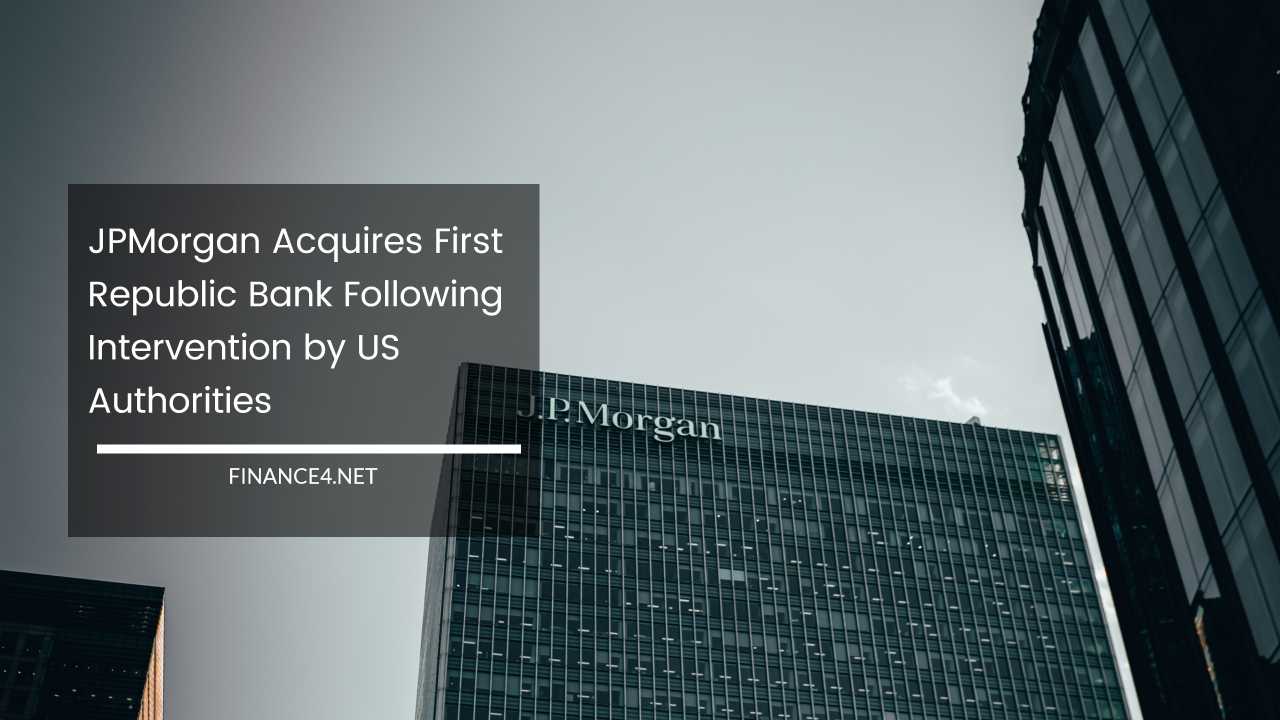JPMorgan Acquires First Republic Bank Following Intervention by US Authorities

JPMorgan
Collapse of First Republic Bank: JPMorgan Steps In after US Authorities’ Intervention
In the United States, the financial crisis has claimed another regional bank. First Republic Bank has become the latest casualty, following the recent setbacks experienced by Silicon Valley Bank and Signature Bank just last month.
In the early hours of Monday, around 3 a.m. Washington time (9 a.m. in mainland Spain), the Federal Deposit Insurance Corporation (FDIC) announced the intervention of First Republic Bank and a subsequent sale agreement with JPMorgan, the largest bank in the United States.
As part of the deal, JPMorgan will assume all deposits and virtually all of the bank’s assets. The announcement explicitly states that First Republic Bank depositors will transition to becoming JPMorgan depositors.
In light of the recent banking crises, US regulators have recommended increasing the deposit insurance guarantee amount, currently set at $250,000, in order to prevent financial panics among clients.
“Our government invited us and others to take a step forward, and we have done so,” stated Jamie Dimon, the president and CEO of JPMorgan Chase, emphasizing the bank’s commitment to stepping in during times of crisis.
JPMorgan Chase has a long-standing tradition of assisting and supporting competitors when needed. Dimon further highlighted the bank’s financial strength, capabilities, and business model, which enabled them to formulate an offer that minimizes costs to the Federal Deposit Insurance Corporation (FDIC).
The extensive preparations for the acquisition were undertaken by approximately 800 bank employees, who dedicated their efforts to meticulously reviewing First Republic’s data and developing the offer.
Their collective expertise and diligence ensured a well-prepared and informed decision-making process regarding the transaction.
JPMorgan’s acquisition of First Republic Bank comes at a price of $10.6 billion, but only after the target bank’s balance sheet has been thoroughly cleaned up.
The FDIC has acknowledged that the rescue operation will cost the Deposit Insurance Fund approximately $13 billion. As part of the agreement, both the FDIC and JPMorgan will share the losses incurred by First Republic Bank on its outstanding residential and commercial loans.
In contrast, JPMorgan is poised to experience an initial gain of approximately $2.6 billion after taxes, although this amount does not factor in the estimated $2 billion in after-tax restructuring costs anticipated over the next 18 months.
Despite these near-term expenses, Jamie Dimon expresses confidence in the profitability of the operation in the medium and long term. He anticipates that the transaction will have a positive impact on earnings per share, resulting in over $500 million of additional net income per year, excluding the aforementioned figures.
Additionally, the acquisition carries the intangible benefit of stemming the spread of the crisis and safeguarding the stability of the financial system as a whole.
The 84 branches of First Republic Bank, located across eight states in the United States, seamlessly transitioned into JPMorgan’s operations from the very Monday following the acquisition.
JPMorgan has assured analysts that it is committed to treating First Republic employees with respect, care, and transparency.
However, the preservation of their jobs is not guaranteed, and the buyer aims to minimize layoffs to the best of their ability.
First Republic Bank had been at the center of the storm, experiencing significant stock market collapses the previous week after reporting a substantial flight of deposits in March.
The bank’s intervention appeared imminent, and it was confirmed after a weekend of intense negotiations, during which authorities sought to address the crack it represented in the financial system.
The primary objective, as in previous bailouts orchestrated over the weekend, was to halt the ongoing outflow of deposits.
The deposit outflows were fueled by a spiral of negative news and declining stock prices, jeopardizing the bank’s viability and risking an uncontrolled and chaotic bankruptcy scenario.
Founded in 1985, First Republic is a financial institution that has its headquarters located in San Francisco.
The bank has established branches primarily in California and has a notable presence in high-net-worth urban areas on the East Coast. By the end of 2022, First Republic ranked as the 14th-largest bank in the United States in terms of asset size.
First Republic experienced a significant event in its history, as it became the second-largest bank to fail in the United States.
The largest bank to fail prior to First Republic was Washington Mutual. In 2008, JP Morgan acquired Washington Mutual, making it the largest bank acquisition in the history of the United States at that time.
First Republic faced a combination of solvency and liquidity issues. A significant factor contributing to these problems was the presence of substantial unrealized losses on a mortgage portfolio consisting of loans with very low fixed interest rates.
These losses amounted to a considerable $27 billion difference between the market value of the assets and their book value.
Despite these losses being unrealized, the bank managed to meet regulatory capital requirements on paper and even reported profitable results. However, this apparent financial stability was, in reality, deceptive.
During the first quarter, First Republic experienced a significant outflow of funds as its clients withdrew a total of $102 billion from their accounts.
Simultaneously, JP Morgan and other institutions injected $30 billion in deposits into the bank. To address the liquidity strain, First Republic had to resort to funding from the Federal Reserve.
Out of the total amount of $30 billion in deposits injected into First Republic, $5 billion came from JP Morgan. In a presentation to analysts and investors, JP Morgan’s CEO, Jamie Dimon, stated that the bank intends to return the remaining $25 billion to the major entities that participated in the initial attempt to support First Republic.
Amid a crisis of confidence, First Republic made efforts to restore its balance sheet and income statement by canceling the dividend and eliminating the payment of preference shares.
However, despite these endeavors, all attempts proved futile, and JPMorgan prevailed in the bidding process initiated by the authorities.
According to the Federal Deposit Insurance Corporation (FDIC) report, as of April 13, First Republic had $229.1 billion in total assets and $103.9 billion in deposits. As part of the acquisition process, JPMorgan will retain a significant portion of First Republic’s assets and deposits. Specifically, JPMorgan will keep $173 billion in loans and $92 billion in deposits.
For customers who have not transitioned their accounts to another financial institution, they will have the opportunity to continue using their current First Republic branches.
However, to access JPMorgan’s offices and services, these customers will need to await a notification from the new owner regarding the necessary procedures and any changes in branch usage.
By providing a bailout to what had been perceived as the weakest link in the US financial system for several weeks, the authorities aimed to quell the crisis and halt the contagion that initially began with the collapse of Silicon Valley Bank. While the bailout offers some relief, its broader effects remain to be seen.
One potential consequence of the bailout is the introduction of credit restrictions that could impede economic growth.
This outcome hinges on whether the authorities impose tighter regulations and oversight to prevent similar crises in the future.
Additionally, the bailout may result in a lower rate of interest rate hikes by the Federal Reserve as a means to stabilize the financial system and stimulate economic recovery.
Furthermore, the regional banks may face a situation of general weakness due to depositors perceiving them as more fragile.
This perception has led many depositors to transfer their savings to larger institutions like JPMorgan. In fact, JPMorgan experienced a significant increase of $37 billion in deposits during the first quarter, further consolidating its position as a trusted and stable entity in the eyes of the market.
The market’s response to the acquisition has been largely positive for JPMorgan. The bank’s shares rose more than 3% at the opening on Wall Street, indicating investor confidence in its ability to navigate the crisis and capitalize on the acquisition.
Conversely, the shares of First Republic were suspended from trading, rendering them worthless in the wake of the bank’s downfall.



